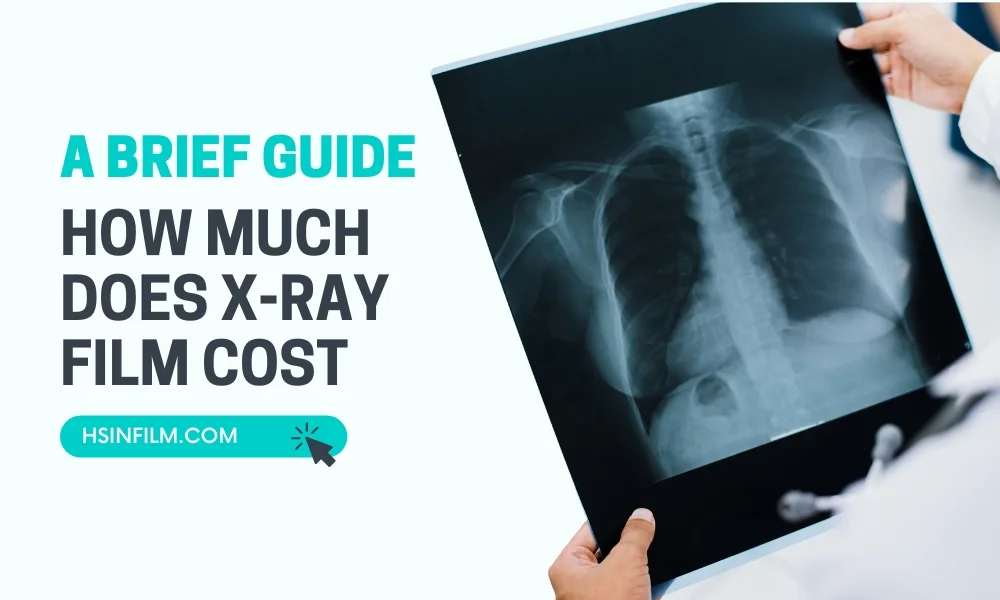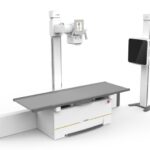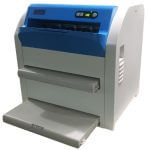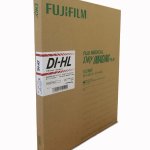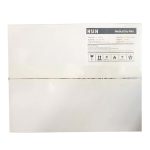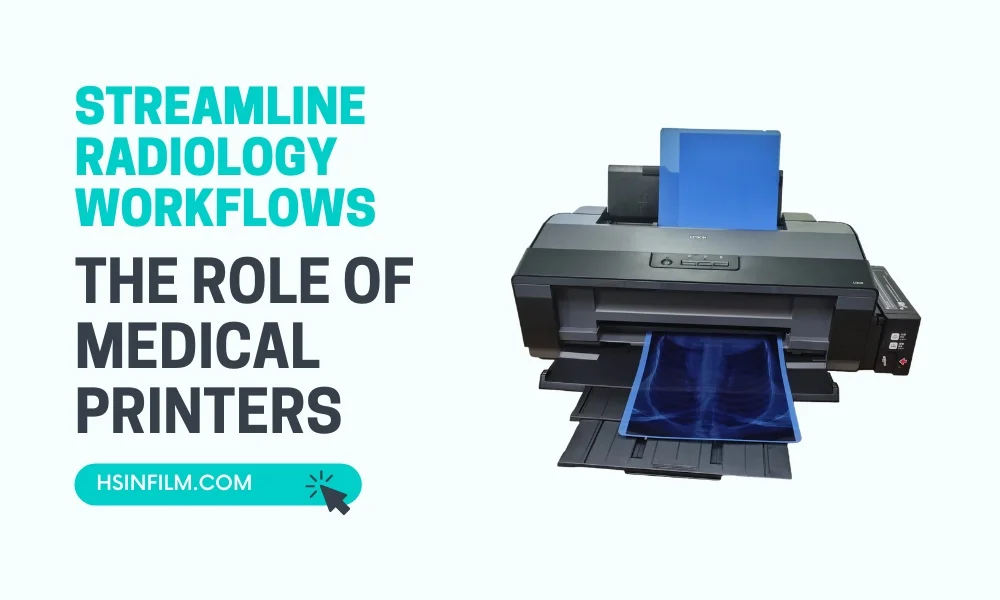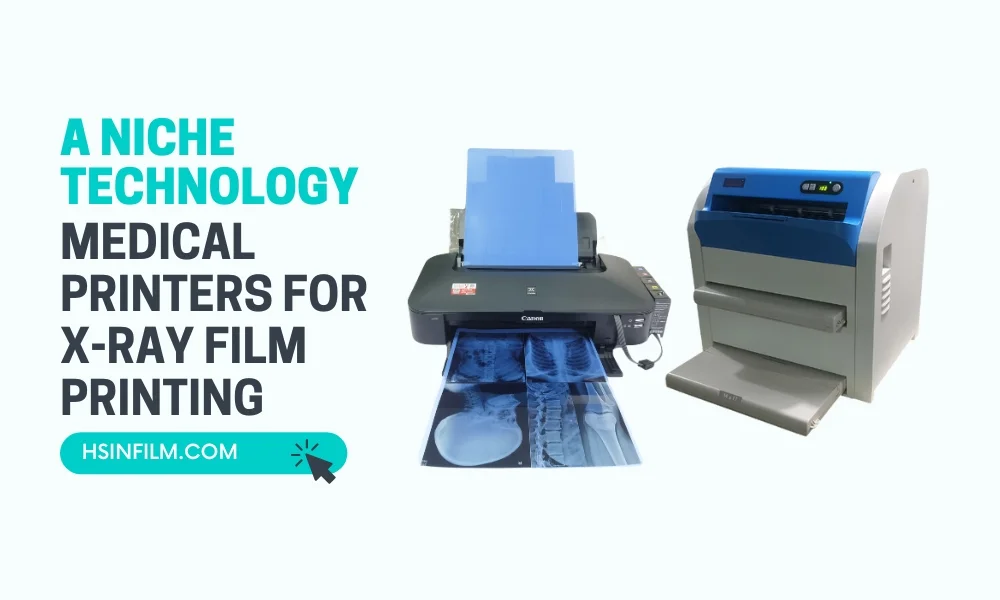X-ray films play a crucial role in the field of healthcare, allowing medical professionals to diagnose and treat a wide range of medical conditions. We will provide you with valuable insights that can help you make informed decisions and better manage X-ray film costs while ensuring high-quality patient care. In this brief guide, we will delve into the various factors that influence the cost of X-ray film, helping you gain a deeper understanding of the pricing dynamics in the medical imaging industry.
Table of Contents
Understanding the Importance of X-ray Film
X-ray films are essential diagnostic tools that have been used in medical imaging for decades. They allow healthcare providers to visualize the internal structures of the body, including bones, organs, and tissues, helping identify injuries, diseases, and abnormalities. X-ray films are widely used in various medical fields, such as orthopedics, cardiology, dentistry, and emergency medicine. The clarity and accuracy of these images are vital in guiding medical professionals toward appropriate treatment plans.
Factors Affecting the Cost of X-ray Film

The cost of X-ray film is influenced by several key factors that can vary based on market demand, production processes, and specific healthcare needs. Understanding these factors helps healthcare providers make informed decisions when purchasing X-ray film, ensuring they balance quality, efficiency, and budget constraints. Below are the primary factors that affect the cost of X-ray film:
1. Film Speed and Sensitivity
X-ray films come in different speeds, which refer to their sensitivity to radiation. High-speed films require less radiation to produce an image, while low-speed films require more exposure for a clearer image.
- High-Speed Films: These films tend to be more expensive because they reduce patient radiation exposure and speed up the imaging process. High-speed films are often preferred in environments where time and patient safety are priorities, such as emergency rooms.
- Low-Speed Films: Though lower in cost, these films may result in a higher radiation dose for the patient. They may also offer better image resolution, making them suitable for detailed imaging, but are generally slower to process.
2. Film Size and Type
The size and type of X-ray film also significantly affect its cost. Different medical procedures require specific film sizes to capture the necessary images, and larger films or specialty films will naturally be more expensive.
- Standard Film Sizes: Common sizes, like 8 x 10 inches or 14 x 17 inches, are typically produced in bulk and have lower prices due to economies of scale.
- Specialty Films: Films used for niche procedures (e.g., dental or mammography X-rays) may have higher production costs and limited demand, leading to higher prices.
3. Brand and Manufacturer
The brand of X-ray film plays a significant role in its pricing. Established manufacturers with a reputation for quality and consistency may charge more for their products.
- Premium Brands: Well-known brands like Fujifilm, Kodak, and Carestream are often more expensive but are trusted for producing high-quality, reliable films. These brands also offer better customer service and warranties.
- Generic Brands: Lesser-known or generic brands tend to be more affordable. However, these films may not always deliver the same level of image quality or consistency.
4. Geographical Location and Shipping Costs
X-ray film prices can vary by region, depending on factors such as local demand, import taxes, and shipping costs. The distance between the manufacturer and the healthcare facility impacts the final cost, especially for facilities in remote or developing areas.
- Domestic vs. Imported Films: Films manufactured locally may be cheaper due to lower transportation costs. On the other hand, imported films can be subject to additional taxes, tariffs, and shipping fees, raising their price.
- Regional Variations: In developing countries, X-ray film may cost more due to lower availability and increased import costs. Meanwhile, facilities in developed countries may benefit from more stable and competitive pricing.
5. Bulk Purchases and Contract Pricing
Buying X-ray film in bulk or through long-term contracts can significantly reduce the per-unit cost. Many suppliers offer discounts for large orders, particularly to hospitals or clinics that use high volumes of X-ray film.
- Bulk Discounts: Larger healthcare facilities can negotiate better rates by purchasing X-ray film in large quantities. This also helps suppliers ensure steady demand, making it a win-win situation.
- Contract Pricing: Some suppliers offer long-term contracts, locking in prices for an extended period. This can be beneficial for facilities looking to stabilize costs over time, though it may also limit flexibility in switching suppliers.
6. Technological Advancements
As the medical imaging industry moves towards digital solutions, traditional X-ray films are becoming less common in some areas. However, advances in film manufacturing processes can also impact the cost.
- Digital Alternatives: Many healthcare facilities are switching to digital radiography (DR) or computed radiography (CR) systems, which do not require traditional X-ray film. This shift reduces demand for film and may cause fluctuations in pricing, with film becoming more expensive as production scales down.
- Hybrid Solutions: Facilities using both digital and film systems may incur higher costs due to the need to maintain two types of imaging supplies and equipment.
7. Supply Chain Disruptions
The global supply chain plays a critical role in determining the price of X-ray film. Disruptions in raw material sourcing, production, or logistics can lead to price hikes.
- Raw Material Costs: X-ray films are made using specific chemicals, silver halides, and other materials. Any fluctuation in the price of these raw materials, such as increases in silver costs, can drive up film prices.
- Global Events: Pandemics, trade restrictions, or political events can cause delays in production or increase shipping costs, which in turn raises the price of X-ray film.
8. Environmental Regulations
Environmental factors and regulations can influence production costs for X-ray film, which may be passed on to healthcare facilities in the form of higher prices.
- Sustainability Standards: Some regions impose strict environmental standards on manufacturers, requiring them to adopt more eco-friendly processes. This can increase production costs, particularly if film production involves hazardous chemicals that need special handling.
- Recycling and Disposal Costs: X-ray film contains silver, which must be disposed of properly. Facilities that do not have efficient recycling systems may need to pay additional fees for the safe disposal of used film, increasing the overall cost of using X-ray film.
9. Customization and Specialty Needs
Certain medical applications require customized or specialized X-ray films that differ from standard films. These films, designed for unique imaging procedures, often come with higher price tags due to their limited production.
- Customization: Films designed for specific medical procedures, such as angiography or fluoroscopy, are typically more expensive because they are tailored to deliver very specific image qualities.
By understanding these factors, healthcare providers can make informed decisions about purchasing X-ray films, ensuring that they meet their imaging needs while maintaining cost-efficiency. Making use of bulk purchasing discounts, exploring contract pricing, and staying updated on the latest technological advancements can all help to optimize the cost of X-ray film for medical imaging facilities.
Check our high-quality and affordable medical X-ray films for your medical business.
Cost Comparison of Different X-ray Film Types
When considering the purchase of X-ray film, several factors influence the price, including the type of film, size, speed, brand, and quantity purchased. Here is a general breakdown of cost ranges for different types and sizes of X-ray films:
1. Standard X-Ray Film (Analog)
Analog X-ray film is still widely used in medical and dental settings. The price varies based on the size, speed, and quantity, with some brands offering more specialized films at higher costs.
- Small Sizes (8×10 inches):
- Cost Range: $30 – $80 per box of 100 sheets
- Speed: Higher speed films generally cost more, as they require less radiation for exposure.
- Brands: Major brands like Kodak, Agfa, and Carestream offer different price points, with Kodak and Carestream typically being slightly more expensive due to their brand reputation.
- Medium Sizes (10×12 inches, 11×14 inches):
- Cost Range: $60 – $150 per box of 100 sheets
- Speed: Fast-speed films, such as 400 speed, tend to cost around 10-20% more than slower-speed options like 100 speed.
- Large Sizes (14×17 inches):
- Cost Range: $90 – $250 per box of 100 sheets
- Applications: These larger films are typically used for chest X-rays and other large anatomical areas.
- Brand Variance: Some high-end brands, like Konica Minolta and Fuji, may be at the higher end of this price range.
2. Dental X-Ray Film
Dental films are smaller in size but still vary in price based on speed and quantity.
- Bitewing X-Ray Film (Size 0, 1, or 2):
- Cost Range: $25 – $60 per box of 150-200 sheets
- Speed: Most dental films are either D-speed or F-speed, with F-speed films being faster and slightly more expensive.
- Panoramic X-Ray Film:
- Cost Range: $50 – $100 per box of 50 sheets (12×30 cm)
- Application: Panoramic films cover the entire jaw and are typically used in orthodontics or complex dental assessments.
3. Mammography X-Ray Film
Mammography requires high-contrast, high-resolution films, which tend to be more specialized and, therefore, more expensive.
- Sizes (18×24 cm, 24×30 cm):
- Cost Range: $120 – $250 per box of 100 sheets
- Speed: Mammography films are usually slow speed (e.g., 100) to produce sharp images with fine detail, contributing to the higher cost.
4. Computed Radiography (CR) Film
CR films are used with digital systems but still require printing. These films typically come in larger sizes and higher-quality material.
- Medium Sizes (8×10 inches, 10×12 inches):
- Cost Range: $100 – $250 per box of 100 sheets
- Brand: Popular brands include Carestream, Agfa, and Fuji, with Fuji CR films often being at the higher end of the price range.
- Large Sizes (14×17 inches):
- Cost Range: $150 – $350 per box of 100 sheets
- Speed: CR films offer multiple speed options, but the cost generally does not vary significantly based on speed in CR systems.
5. Dry Laser X-Ray Film
Dry laser films are used in digital radiography systems, often for high-quality prints from digital images.
- Small Sizes (8×10 inches):
- Cost Range: $150 – $250 per box of 100 sheets
- Speed: Speed is generally less of a factor in dry laser film pricing compared to analog films.
- Medium to Large Sizes (10×12 inches, 14×17 inches):
- Cost Range: $200 – $500 per box of 100 sheets
- Brand: High-quality dry laser films from brands like Kodak and Fuji tend to be more expensive but offer superior image clarity and durability.
6. Medical Thermal Film
Thermal films are specifically designed for thermal printers and are increasingly popular for digital imaging systems.
- Sizes (8×10 inches, 10×12 inches, 14×17 inches):
- Cost Range: $200 – $450 per box of 100 sheets
- Applications: These films are frequently used in ultrasound and CT/MRI scans. Thermal films generally have a longer shelf life and produce consistent image quality, which contributes to their higher cost.
Factors Influencing Costs
- Speed: Faster-speed films (like 400 speed) generally cost more because they require less radiation, offering greater patient safety.
- Brand: Established brands like Kodak, Carestream, and Fuji tend to command higher prices due to their reputation for producing high-quality images.
- Quantity Discounts: Larger orders often come with bulk discounts. Buying boxes of 500 or 1,000 sheets can reduce the cost per sheet.
The cost of X-ray films varies greatly depending on the type, size, speed, and brand. Dental films are generally more affordable than those used in mammography or dry laser imaging systems. Healthcare facilities should carefully consider their specific imaging needs, budget, and expected usage levels when choosing which type and size of film to purchase.
Impact of Regional Variations in Pricing for X-Ray Film
The cost of X-ray film can vary significantly depending on the region, with noticeable differences between developed and developing countries. These variations arise from factors like local manufacturing capabilities, import taxes, healthcare infrastructure, demand, and currency fluctuations. Here’s a detailed look at the impact of regional pricing differences:
1. Manufacturing and Supply Chain Costs
- Developed Countries: X-ray films in developed nations like the United States, Canada, the United Kingdom, and parts of Europe are often priced higher due to local manufacturing standards, higher labor costs, and strict regulations. These countries may also rely on advanced healthcare technology, which can lead to a preference for higher-end brands like Kodak, Agfa, or Fuji.
- Developing Countries: In regions like Africa, Southeast Asia, or parts of Latin America, local manufacturing may not be as widespread, and many countries rely heavily on imported films. This can increase costs due to shipping fees, import taxes, and tariffs. However, the presence of lower-cost, locally manufactured alternatives, or lesser-known brands, can make film more affordable in some cases.
2. Healthcare Infrastructure and Demand
- Developed Countries: In developed nations, healthcare systems often have a higher demand for advanced imaging technologies, including digital imaging and computed radiography (CR), which may limit the demand for traditional X-ray films. However, the remaining demand is typically met with high-quality, premium-priced films.
- Developing Countries: In developing countries, analog X-ray systems are still widely used due to lower initial equipment costs. As a result, the demand for analog X-ray films remains higher. In many cases, governments or NGOs provide funding to subsidize healthcare costs, which can reduce the prices of X-ray films in public healthcare facilities.
3. Regulatory and Import Factors
- Developed Countries: Countries with strict regulatory requirements for medical devices and supplies may see higher prices for X-ray films due to the costs associated with meeting these standards. These include safety testing, quality assurance processes, and compliance with local healthcare regulations, all of which can drive up the end price for healthcare facilities.
- Developing Countries: In developing countries, import duties and tariffs can further increase costs. However, some countries may enter trade agreements or provide government subsidies to lower these prices. In certain regions, counterfeit or lower-quality films may also be available at a lower price point, though these pose risks in terms of image quality and diagnostic accuracy.
4. Currency Exchange Rates and Economic Stability
- Developed Countries: Prices in developed countries may remain relatively stable due to stronger economies and stable currencies. However, fluctuations in the global supply chain (e.g., during economic downturns or pandemics) can still lead to price changes, especially for imported products.
- Developing Countries: In regions with weaker currencies or economic instability, the price of imported X-ray films can fluctuate widely. Depreciating local currencies can make imports more expensive, driving up the costs for healthcare facilities. Inflation and inconsistent supply chains can also lead to price volatility.
5. Access to Advanced Imaging Technologies
- Developed Countries: The healthcare systems in developed countries have largely shifted toward digital radiography (DR) and computed radiography (CR) systems, which reduce the demand for traditional X-ray film. However, when X-ray films are still in use, the costs can be high due to the specialized nature of film production for these advanced systems.
- Developing Countries: Traditional X-ray films remain the dominant choice in many developing countries where the cost of upgrading to digital systems is prohibitive. As a result, there is a larger market for affordable, analog X-ray film, leading to more competitive pricing from manufacturers looking to supply these regions.
6. Price Comparison Examples
- Developed Country (United States): A box of 14×17-inch laser dry film from a major brand like Kodak or Fuji may cost around $300 – $500 per box of 100 sheets. These prices are influenced by strict quality standards and advanced manufacturing processes.
- Developing Country (India): The same 14×17-inch laser dry film could cost around $200 – $350 per box of 100 sheets in India, where local suppliers or government healthcare subsidies might reduce overall costs.
- Developed Country (United Kingdom): Dental X-ray film, for example, may cost around £40 – £70 per box of 150 sheets in the UK, depending on the brand and speed of the film.
- Developing Country (Kenya): The same dental X-ray film might be priced at $20 – $50 per box of 150 sheets in Kenya, though the availability of lower-cost alternatives may play a role in reducing prices.
While developed countries may have higher prices due to strict regulations, high labor costs, and preference for premium brands, developing nations often experience price variations based on access to imported films, government subsidies, and demand for analog systems. Understanding these regional differences is crucial for healthcare facilities when budgeting for X-ray film purchases.
Tips to Manage X-ray Film Costs Effectively
Healthcare facilities and dental practices that rely on X-ray film can significantly reduce costs through bulk purchases or establishing long-term contracts with suppliers. These strategies offer several advantages, including lower unit prices, better negotiation power, and a steady supply of film. Below are key factors to consider when looking at potential cost savings through bulk buying and long-term agreements:
1. Bulk Purchasing Discounts
One of the most straightforward ways to save money on X-ray film is by purchasing in larger quantities. Suppliers often offer discounts for bulk orders because it reduces their logistical costs and ensures more significant sales. Here’s how bulk purchasing can lead to savings:
- Reduced Unit Price: When purchasing large quantities, the cost per unit (or per sheet) decreases. For example, a box of 100 sheets of standard 14×17-inch X-ray film might cost $200 when purchased individually. However, buying five boxes at once might reduce the per-box price to $180, saving the facility $20 per box or $100 overall.
- Lower Shipping Costs: Buying in bulk reduces the frequency of shipments, leading to lower overall shipping costs. In some cases, suppliers might offer free shipping on larger orders, further reducing the overall expense.
- Fewer Price Fluctuations: Prices for medical supplies, including X-ray film, can fluctuate based on market demand, manufacturing costs, and supply chain disruptions. By purchasing in bulk, facilities can lock in a lower price before potential increases, protecting their budget from future price hikes.
2. Long-Term Contracts with Suppliers
Negotiating long-term contracts with suppliers offers even more substantial savings than one-off bulk purchases. These contracts create a stable, mutually beneficial relationship between healthcare providers and suppliers, leading to several cost-saving advantages:
- Volume-Based Discounts: In long-term agreements, suppliers may provide discounted rates based on guaranteed purchases over time. For example, if a facility commits to purchasing a set amount of X-ray film per year, the supplier may offer lower prices due to the assurance of continuous business. This can lead to savings of 5-20% compared to buying film on an as-needed basis.
- Fixed Pricing: Long-term contracts often come with fixed pricing for the duration of the agreement. This shields healthcare providers from price increases due to inflation, supply chain issues, or changes in demand, making budget planning more predictable.
- Priority Access: Suppliers may prioritize long-term contract holders when stocks are limited, ensuring a continuous supply of X-ray film even during shortages. This can prevent disruptions in patient care and avoid the higher costs associated with emergency purchases.
- Tailored Agreements: Facilities can negotiate custom terms in long-term contracts to meet specific needs, such as staggered deliveries or payment terms. This flexibility allows for better cash flow management and the ability to store X-ray film without overcrowding.
3. Supplier Relationships and Negotiation Power
Strong relationships with suppliers lead to better negotiation outcomes for bulk purchases or long-term contracts. Healthcare providers that consistently buy from the same supplier can benefit in several ways:
- Customized Discounts: Suppliers are more likely to offer personalized discounts to loyal customers. If a facility has been purchasing film regularly, they may negotiate additional savings on top of bulk or contract discounts.
- Increased Flexibility: With long-term contracts, suppliers may be more willing to accommodate specific requests, such as rush orders, film customization, or flexible payment schedules, at no extra cost.
- Supplier-Specific Promotions: Suppliers often offer promotional discounts or special offers for their regular customers. These promotions can further reduce the cost of X-ray film if facilities are aware of and can take advantage of these deals.
4. Stockpiling Considerations
While bulk purchases and long-term contracts can save money, healthcare facilities need to consider the storage and shelf-life of X-ray films:
- Storage Requirements: X-ray films require specific storage conditions, including controlled temperature and humidity levels, to prevent degradation. Facilities that buy in bulk need to ensure they have adequate storage to maintain the quality of the films over time. Improper storage could lead to losses that negate the savings from bulk purchases.
- Shelf Life: X-ray film has a shelf life, usually between 12 to 24 months. Bulk purchasing makes sense if a facility uses large quantities regularly. However, smaller facilities with lower demand should be cautious about ordering more than they can use within the film’s expiration period.
5. Other Cost-Saving Considerations
- Payment Terms: Long-term contracts may offer better payment terms, such as extended payment schedules, which can help manage cash flow more effectively. Bulk orders may also come with payment options like delayed or installment payments, offering further financial flexibility.
- Supplier Loyalty Programs: Some suppliers offer loyalty programs where healthcare facilities can accumulate points or rewards with each purchase, which can be redeemed for discounts or free products. Over time, this can lead to additional savings, especially for high-volume purchasers.
- Group Purchasing Organizations (GPOs): Healthcare facilities that are part of a Group Purchasing Organization can access even greater discounts on X-ray films. GPOs negotiate bulk purchases on behalf of multiple organizations, allowing smaller facilities to benefit from the cost advantages usually reserved for large institutions.
6. Example of Cost Savings
A medium-sized healthcare facility needs to purchase 14×17-inch dry laser X-ray film for its radiology department. Here’s a comparison of costs with different purchasing strategies:
- Regular Purchases (No Contract):
- 100 sheets: $300 per box
- Annual purchase (5 boxes): $1,500
- Bulk Purchase (5 boxes at once):
- Discounted rate: $275 per box
- Total for 5 boxes: $1,375
- Savings: $125
- Long-Term Contract (Annual commitment for 10 boxes):
- Negotiated rate: $250 per box
- Total for 10 boxes: $2,500
- Annual Savings: $500 compared to regular purchases
Bulk purchases and long-term contracts with suppliers offer substantial cost savings for healthcare facilities that regularly use X-ray film. Through lower unit prices, reduced shipping costs, and fixed pricing, facilities can optimize their spending. However, considerations like storage capacity, shelf life, and the specific needs of the facility must be carefully managed to ensure that these savings are fully realized.
Government Subsidies and Grants for X-Ray Film in Healthcare Facilities
To help healthcare facilities manage operational costs, including the expense of X-ray film and other medical supplies, governments and international organizations often provide subsidies, grants, or funding programs. These financial aids are designed to support hospitals, clinics, and other healthcare providers in delivering essential services, especially in regions where medical resources are limited or healthcare costs are high. Here’s an overview of some common forms of financial support available:
1. Government Subsidies for Healthcare Supplies
Many governments, especially in developing countries, offer subsidies to help healthcare facilities purchase critical medical supplies, including X-ray films. These subsidies can take different forms, such as tax exemptions, direct financial aid, or price controls. Here are some examples:
- Direct Subsidies: Governments may directly allocate funds to healthcare facilities to offset the cost of purchasing medical supplies. These subsidies may come from public health budgets or emergency healthcare programs. In some countries, public hospitals and clinics receive automatic subsidies for essential supplies like X-ray film.
- Tax Exemptions: Some governments offer tax exemptions or reductions on the purchase of medical supplies, including X-ray films, for healthcare facilities. This reduces the overall cost of these supplies, especially for public or nonprofit healthcare institutions. Tax exemptions may also apply to imported medical goods, helping lower costs for facilities that rely on international suppliers.
- Price Controls: In countries where the government regulates healthcare costs, there may be price controls on essential medical supplies, such as X-ray films. This ensures that healthcare facilities can purchase these products at more affordable rates, keeping costs within the reach of hospitals and clinics that serve low-income populations.
2. Healthcare Grants for Medical Equipment and Supplies
Grants are another form of financial assistance that healthcare facilities can use to offset the cost of X-ray film. Governments, nonprofit organizations, and international agencies often provide grants aimed at improving healthcare services. Some examples include:
- National Healthcare Grants: Many countries offer healthcare grants as part of larger healthcare infrastructure improvement projects. For example, the United States provides healthcare facilities with access to grants through programs like the Health Resources and Services Administration (HRSA) for equipment purchases, which may include imaging equipment and related supplies like X-ray film.
- Public Health Grants: Governments, through health ministries or departments, sometimes offer grants that target specific public health goals. Facilities working in rural areas or underserved regions may qualify for grants to purchase X-ray film as part of a broader public health initiative, such as tuberculosis screening or maternal health programs.
- International Health Organization Grants: International organizations like the World Health Organization (WHO) or the United Nations (UN) provide grants to help developing countries improve their healthcare systems. These grants may cover the costs of diagnostic tools, including X-ray films, to support medical imaging needs in low-resource settings.
3. NGO and Nonprofit Funding for Medical Supplies
In many cases, non-governmental organizations (NGOs) and nonprofit entities provide financial support to healthcare facilities, especially in developing countries. These organizations may focus on specific medical needs or regions and often help by donating or subsidizing medical supplies, including X-ray film.
- Nonprofit Donations: NGOs like Médecins Sans Frontières (Doctors Without Borders) and the Red Cross often provide medical supplies, including imaging tools and X-ray films, to healthcare facilities in crisis-affected or underfunded areas. They also partner with local governments to ensure continued access to essential medical resources.
- Grants from Foundations: Foundations like the Bill & Melinda Gates Foundation provide grants to improve healthcare infrastructure in developing countries. These grants may be used to purchase diagnostic tools, including imaging equipment and X-ray film, for maternal health, infectious disease control, and general medical services.
4. Subsidies for Digital Conversion and Hybrid Systems
As many healthcare facilities transition from traditional film-based X-rays to digital radiography (DR) or computed radiography (CR) systems, some governments offer financial assistance to ease this transition. These programs may still cover X-ray film costs for facilities using hybrid systems or for those unable to fully switch to digital imaging.
- Digital Imaging Grants: In countries like the United States, programs such as the Medicare & Medicaid EHR Incentive Programs (Meaningful Use) encourage the adoption of digital medical records and imaging systems. While primarily focused on digital technologies, healthcare facilities can use part of the funding to maintain X-ray film systems during the transition period.
- Energy Efficiency Subsidies: Some governments offer subsidies for energy-efficient medical equipment, including X-ray printers and film processors. These programs reduce the operating costs of medical imaging departments and can indirectly lower the total expenditure on X-ray film.
5. Regional and International Development Programs
In addition to national subsidies and grants, regional and international development programs offer financial assistance to healthcare facilities, particularly in low- and middle-income countries. These programs aim to improve access to healthcare resources, including diagnostic imaging tools like X-ray film.
- African Development Bank (AfDB): In African countries, the AfDB often provides funding for healthcare improvements. This funding can be used to purchase medical supplies like X-ray film, as part of broader projects to strengthen healthcare services in rural or underserved areas.
- World Bank Health Projects: The World Bank also funds healthcare initiatives in developing countries. Hospitals and clinics can apply for funding to support the purchase of medical equipment, including imaging tools. In some cases, the funds may be allocated to cover X-ray film and related supplies.
- European Union (EU) Funding: For countries in the EU or neighboring regions, the EU provides health-related grants that support the purchase of diagnostic tools, including X-ray film, to improve healthcare quality and access.
6. How to Apply for Subsidies or Grants
Healthcare facilities seeking subsidies or grants to offset the cost of X-ray film should consider the following steps:
- Research Available Programs: Begin by researching local, national, and international programs that offer financial assistance for medical supplies. Government health departments, nonprofit organizations, and grant databases are good places to start.
- Prepare Documentation: Most grant or subsidy programs require detailed documentation, including proof of need, financial statements, and a proposal outlining how the funds will be used. Ensure that your facility’s application is comprehensive and meets the specific requirements of each program.
- Work with Suppliers: Many suppliers are familiar with subsidy and grant programs and may offer guidance on how to apply for assistance. Some may also have partnerships with funding agencies or NGOs that can facilitate access to financial support.
By leveraging these resources, facilities can reduce operational costs while maintaining access to high-quality imaging supplies. National programs, international development funds, and nonprofit organizations all provide various forms of financial support to help healthcare providers manage these expenses, especially in low-resource or underserved areas.
Conclusion
In conclusion, understanding the factors influencing the X-ray film cost is vital for healthcare providers seeking to optimize their budget without compromising patient care. By considering factors such as film type, quality, quantity, and purchasing sources, facilities can make informed decisions to manage costs effectively.
